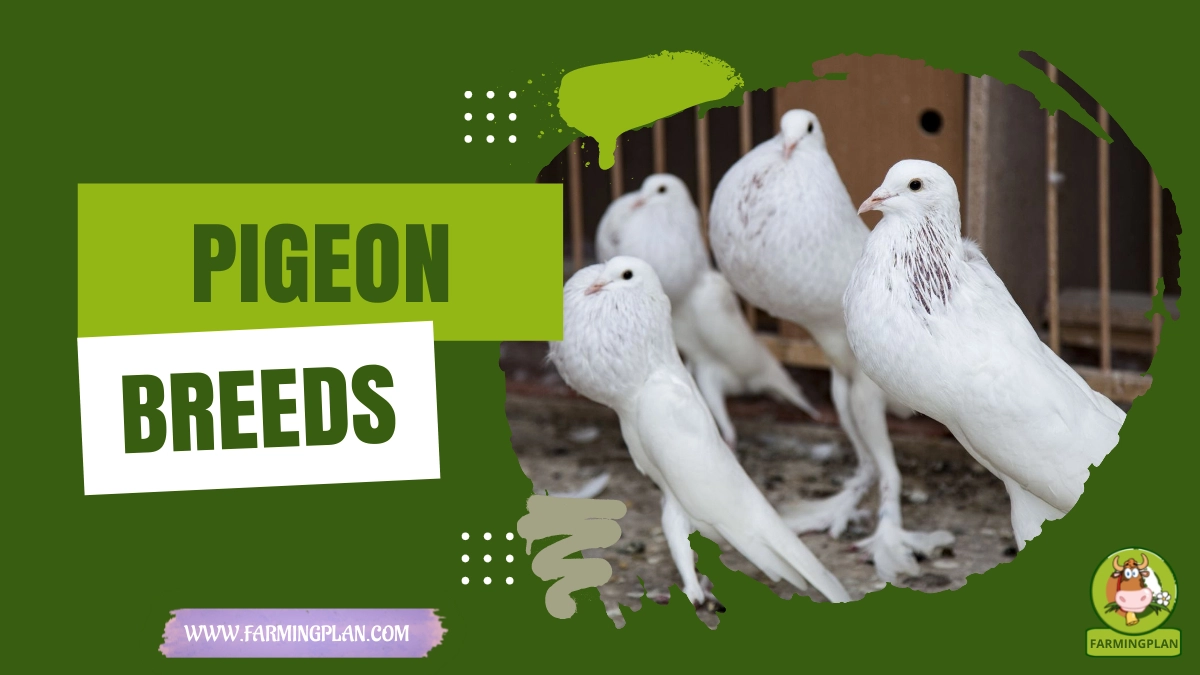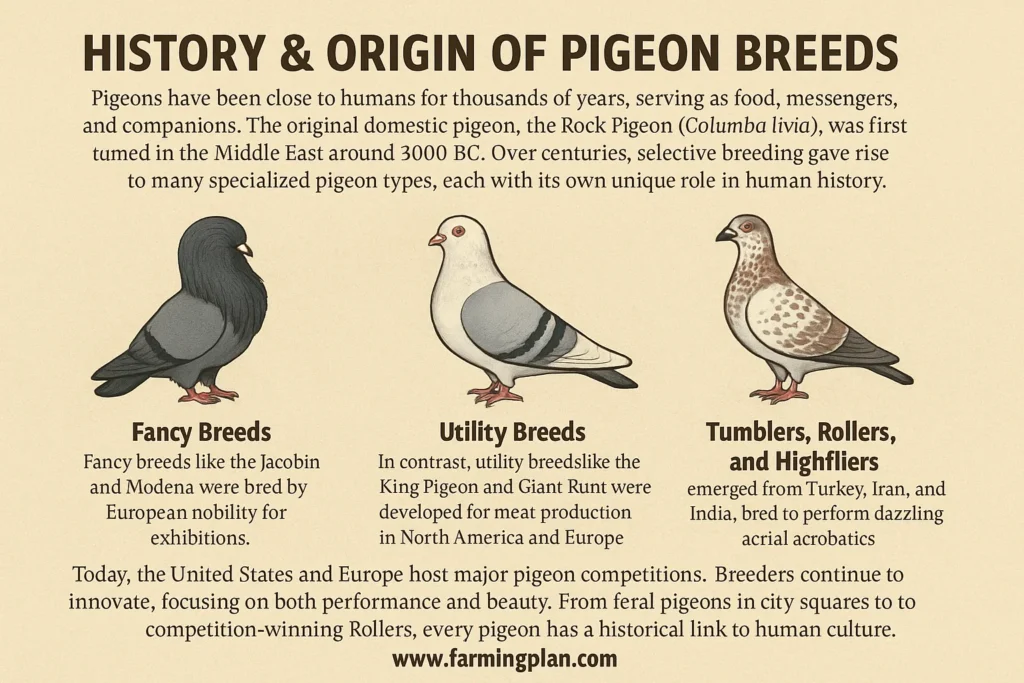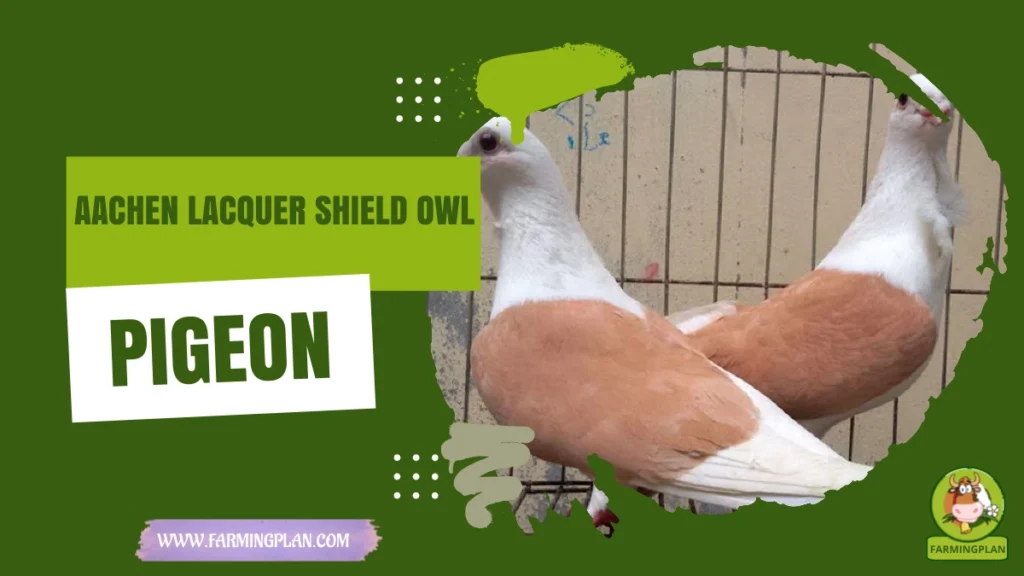If you’ve ever watched a pigeon strut across a park path or roll in mid-air, you’ve probably wondered what kind of bird that was. Welcome to the colorful, quirky, and awe-inspiring world of pigeon breeds. As a breeder and bird enthusiast, I’ve raised dozens of pigeon types—from the dashing Fantail to the muscular Giant Runt. This article explores everything you need to know about the variety of pigeon breeds. We’ll cover their origin stories, appearances, personalities, care tips, feeding, health concerns, and even a step-by-step care guide. Let’s dive into the wonderful world of pigeon breeds.

History & Origin of Pigeon Breeds
Pigeons have been close to humans for thousands of years, serving as food, messengers, and companions. The original domestic pigeon, the Rock Pigeon (Columba livia), was first tamed in the Middle East around 3000 BC. Over centuries, selective breeding gave rise to many specialized pigeon types, each with its own unique role in human history.
Fancy breeds like the Jacobin and Modena were bred by European nobility for exhibitions. In contrast, utility breeds like the King Pigeon and Giant Runt were developed for meat production in North America and Europe. Tumblers, Rollers, and Highfliers emerged from Turkey, Iran, and India, bred to perform dazzling aerial acrobatics.

Today, the United States and Europe host major pigeon competitions. Breeders continue to innovate, focusing on both performance and beauty. From feral pigeons in city squares to competition-winning Rollers, every pigeon has a historical link to human culture.
Read More: Stunning Araucana Chicken Breed Guide for Blue Egg Lovers
Characteristics of Pigeon Breeds
Pigeon breeds are as diverse as they are fascinating. They vary widely in size, color, feather style, beak shape, and body structure. Fancy breeds like the Frillback show off curled feathers, while the Fantail fans out its elegant tail like a peacock.
Pigeons like the Ice Pigeon shine with a frosty sheen on their feathers, making them a favorite among exhibition birds. On the other end, utility pigeons like the Giant Runt have strong, meaty bodies—ideal for squab production. Tumblers and Rollers are slim with powerful wings, bred for high-altitude flights and flips.
Some breeds, like the Old German Owl, have a frilled neck and expressive eyes, adding charm to their already captivating presence. Color patterns range from pure white to deep chocolate, smoky blues, and vibrant speckled combinations. Depending on the breed, their heads can be smooth, crested, or rosettes.
Nature & Temperament of Pigeon Breeds
People often consider pigeons simple birds, but each breed has a unique temperament. From my experience, some are sweet and cuddly, while others are bold, curious, or just plain silly. The Indian Fantail is calm and perfect for beginners, while breeds like the Roller are more energetic and need space to fly.
Breeds like the Pouters are show-offs. They balloon their necks and strut proudly. The Frillback is more laid-back, while Tumblers love exercise and can’t sit still for long. Many fancy breeds are docile, especially if hand-raised. Pigeons are social birds; most prefer to live in pairs or groups. They’re also intelligent and can recognize their human caretakers. Daily interaction allows them to learn basic tricks or come when called.
Many fancy pigeon breeds are incredibly tame—especially when hand-raised. I’ve hand-fed quite a few, and those birds turn into absolute sweethearts. They’ll perch on your hand, follow you around the loft, and even coo when they see you coming. Pigeons are highly social animals, and they hate being alone. They do best in pairs or flocks, where they can build bonds and establish their own little pecking order.
What surprises most new keepers is how smart pigeons are. These birds can recognize faces, learn to fly to their owner’s hand on command, and even understand routines like feeding time. With a bit of daily interaction and gentle handling, pigeons can become incredibly affectionate pets who bond deeply with their caretakers. If you treat them with patience and care, they’ll reward you with loyalty, trust, and years of companionship.
Food & Diet of Pigeon Breeds
Feeding pigeons isn’t complicated, but it’s essential to get it right. A well-balanced pigeon diet includes grains like corn, wheat, peas, millet, and sorghum. I prefer feeding my birds a premixed pigeon seed blend that contains everything they need.
You can supplement their diet with grit, which helps digestion, and calcium (usually as crushed oyster shells or cuttlebone). Fresh, clean water should always be available. I add vitamins during breeding or molting season to support feather growth and chick health.
Avoid feeding them bread, junk food, or anything salty. It might seem cute to feed pigeons leftovers, but processed food can seriously harm their health. And while it might be tempting to share human snacks with your pigeons, steer clear of bread, salty foods, and leftovers—these can do more harm than good. Keep it natural, balanced, and clean for a healthy, thriving flock.
Usage & Purpose of Pigeon Breeds
Pigeons aren’t just “city birds” pecking at crumbs—they’ve got real jobs and talents depending on their breed. Over the years, I’ve raised pigeons for all sorts of reasons: showing, racing, breeding, and simply for the joy of their company. Fancy breeds like the Fantail, Jacobin, and Frillback are prized for their elegant looks and unique feather structures. These are the divas of the pigeon world, often groomed and paraded at exhibitions and shows. Their exotic appearances and calm temperaments make them a favorite among pigeon fanciers and hobby breeders alike.
Then you’ve got your utility pigeons—heavy-bodied birds like the King and Giant Runt. These aren’t show birds; they’re raised for meat, commonly known as squab. I’ve raised Kings myself, and they’re incredibly efficient—they grow fast, stay calm, and have a good feed-to-weight ratio. Their meat is considered a delicacy in many cultures, especially in gourmet restaurants. Then come the racing pigeons, often mistaken for wild birds due to their sleek looks and swift flight. These birds are trained athletes. They can fly hundreds of miles and still find their way home thanks to their amazing homing instinct. In countries like Belgium, the U.S., and China, pigeon racing is a serious sport with real prize money involved.
Of course, not everyone raises pigeons for profit or competition. Many people, especially in urban areas, keep them simply as pets. Their calm behavior and relatively simple care needs make them great companions—even in small apartments. I know folks who keep a pair of fancy pigeons just for their gentle cooing and low-maintenance lifestyle. Educational farms and hobbyists also raise different breeds to teach kids and new enthusiasts about pigeon behavior, genetics, and breeding. No matter your reason, there’s a pigeon breed out there that fits the bill.
Special Features of Pigeon Breeds
Every pigeon breed has something that makes it stand out—and trust me, some of these traits are downright wild. One of the most iconic is the Fantail. Its signature tail can have 30–40 feathers, forming a fan that looks like a mini peacock. They walk with their chest out, almost like royalty. Then there’s the Jacobin—you can barely see its face! Its head is completely surrounded by a hood of thick, curled neck feathers. It’s like a feathered lion’s mane, and yes, it takes real grooming to keep that look clean.
Some breeds are known for what they do, not just how they look. Rollers and Tumblers are bred to flip in the air while flying—it’s mesmerizing to watch. They literally somersault through the sky, and no, it’s not a trained behavior. It’s genetic. One of my personal favorites is the Pouter. These guys puff up their chest so big you’d think they swallowed a balloon. It’s a showy display meant to impress mates or judges, and they sure know how to put on a performance.
Other breeds have rare features you’d never expect in a bird. The Frillback has curled feathers on its wings and tail that almost look artificial—like a feathered ribbon. The Ice Pigeon Breeds, true to its name, has feathers with a frosty blue shimmer that gives it an almost magical look. And let’s not forget the African Owl Pigeon, with its curved beak and chubby little body—it’s adorable and full of personality. All of these traits are the result of generations of careful breeding, proving that pigeons are anything but ordinary.
Read More: San Juan Rabbit: Hardy Survivor With a Wild Past
Health Issues & Prevention of Pigeon Breeds
If you’re serious about raising pigeons, you’ve got to keep an eye on their health. A healthy pigeon Breeds Breeds is active, alert, sleek, and clean. But like any animal, they can fall sick if their needs aren’t met. Some of the most common issues I’ve dealt with include canker (a yellowish mouth/throat infection), coccidiosis (a gut-related disease), and respiratory problems that cause sneezing or labored breathing.

One of the first signs something’s wrong is a change in behavior—if a pigeon’s fluffed up all day, acting sluggish, or producing weird droppings, I take action fast. I isolate the bird immediately and reach out to a vet who knows avian health. The sooner you catch it, the better the outcome. Prevention, though, is always the smarter route. I clean my lofts daily, make sure the bedding stays dry, and rotate natural disinfectants weekly to kill germs without stressing the birds.
Good ventilation is critical, especially in humid areas. I also keep a consistent schedule for deworming and coccidiosis treatment every 3 to 4 months. For me, prevention is about consistency—clean food trays, clean water bowls, and a daily check-up while feeding. These little things keep my flock thriving. If you’re raising pigeons, build these healthy habits into your routine. Your birds will thank you—with beautiful feathers, energetic flights, and plenty of cheerful cooing.
“Every Pigeon Breeds Has A Story—You Just Need To Listen With Your Eyes And Heart.”
Step-by-Step Pet Owner Care Guide – How To Raise Happy Pigeons
Step 1: Choose The Right Breed For You
If you’re starting out, go for low-maintenance breeds like Fantails or Homing Pigeons. They’re friendly and hardy. Fancy breeds require more grooming and loft care.
Step 2: Set Up A Proper Loft Or Cage
Your pigeons need space. An outdoor loft with good ventilation is ideal. I use wooden lofts with mesh windows to keep predators out. A spacious cage works indoors but allows daily flight time in a safe area.
Step 3: Feed Them Right
I use a commercial pigeon seed mix. I refill feeders once daily and clean water containers every morning. I also add grit and calcium supplements regularly.
Step 4: Keep It Clean
I clean the loft or cage floor every 2-3 days. Once a week, I scrub perches, feeders, and trays. Hygiene keeps diseases away.
Step 5: Bond With Your Birds
Spend time with them. Offer treats by hand, speak softly, and watch their habits. It builds trust. Some of my birds even perch on my shoulder!
Step 6: Breeding Tips (Optional)
Use nest boxes with straw. Provide extra calcium. Pair compatible mates and monitor eggs for hatching (takes about 17-18 days).
Expert Tips & Best Practices – Secrets From My Loft
- Always quarantine new birds before adding them to the flock.
- Don’t overcrowd your loft—happy pigeons need space.
- Check your pigeons’ feet and beaks monthly.
- Give baths once a week—they love it, and it keeps feathers clean.
- Observe every day. A watchful eye prevents major issues.
- Use ID bands to keep track of breeds and ages.
- Join a local pigeon club or online forum for advice and support.
FAQs
What is the most popular pigeon breed?
The Fantail is one of the most popular pigeon breeds because of its elegant tail and friendly nature.
How long do pigeons live?
Domestic pigeons can live 10–15 years, sometimes even longer, with good care.
Can pigeons be kept as indoor pets?
Yes, some people keep pigeons indoors. Just ensure they have enough space and time to fly.
What do pigeons eat daily?
They eat grains like corn, peas, millet, and wheat. A commercial pigeon feed mix works best.
Are pigeons easy to train?
Yes, especially homing and racing breeds. They can learn to come when called and fly back home from miles away.
Conclusion
From fancy breeds with dazzling feathers to aerial acrobats that roll mid-air, pigeons are far more than park pests—they’re companions, performers, and showstoppers. If you’ve ever thought about getting into the world of pigeons, now is the perfect time. With a bit of space, the right food, and daily care, these birds can bring joy, purpose, and a surprising amount of personality into your life. As someone who’s raised pigeons for years, I can tell you—there’s no better feeling than watching a bird you’ve raised take flight, return home, or win a ribbon at a show. So why not start today? Your perfect pigeon companion might just be waiting for you.


